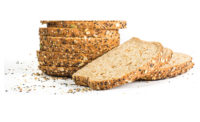Grains mean quality and quantity. Though most people don’t get enough each day, at least half of the grains in a person’s diet should be made up of whole grains, which are unrefined, and haven’t had their bran and germ removed via milling. From corn to quinoa, manufacturers are upping their nutritional antes with whole grains.
According to the Mayo Clinic, at least half of the grains in a person’s diet should be made up of whole grains—unrefined grains that haven’t had their bran and germ removed via milling. For most adults, that means three to five servings of whole grains daily (or two to three for kids). But the truth is, Americans just aren’t meeting this quota. In fact, the Mayo Clinic found that the average American eats less than one serving of whole grains daily, instead loading up on refined grains. The U.S. Department of Agriculture (USDA) nutritional guidelines state that one serving could be as little as one slice of bread, one tortilla, one pancake or one-half cup of cooked pasta, rice or cereal. So clearly, when it comes to grains, it’s a story of both quantity and quality.
In response to refined grains’ prominence in American diets, the USDA mandated that, beginning July 2012, half of the grains offered in schools must meet whole-grain-rich criteria; by July of this year, all grains must meet the criteria.
For a food to qualify as whole-grain-rich, it must contain 100% whole grain. There’s some room for deviation, as the rule allows for blends; however, blends must be at least 50% whole grain, and the remaining grain, if any, must be enriched, meaning that some nutrients lost during processing have been added back in.
“The U.S. Department of Agriculture Food and Nutrition Service is a key driver in the growing demand for whole grains,” explains Todd Giesfeldt, R&D mill product manager at Didion Milling Inc., Cambria, Wis. “Popular food brands are responding to these new requirements and including more whole grains in their recipes.” And the industry is following suit.
According to Dave Sheluga, PhD, director of commercial insights at Omaha, Neb.-based ConAgra Mills, sales of products with whole grain claims are on the rise. “Sales rose from $10 billion in 2010 to $10.5 billion in 2013,” he says. “This includes all food products making a whole-grain or whole-wheat claim. In addition, sales for products making multigrain claims rose from $2 billion in 2010 to $2.3 billion in 2013, although technically, not all products that can say multigrain are also whole grain.”
Sheluga explains that moving forward, whole grains are expected to have a low annual growth rate of about 2-3%, which can be attributed to the overall decline in categories like breakfast cereal, bread and baked goods—common applications for whole grains. “To abate this trend, whole grains have to find growth within declining categories, which can be achieved through ingredient innovation and formulation innovation in combination with consumer insights,” he adds.
Wheat and corn applications
Without a doubt, wheat is the most recognizable grain and flour the most popular application. However, the white, refined standbys take a backseat when customers demand healthier labels. Ingredient suppliers are stepping up to the plate and offering whole-wheat and corn flours that provide the same versatility as their refined counterparts, but with enhanced nutrition.
“In the past, the primary demand for whole-grain flour has been limited to the bread segment, but recently demand has increased in other areas such as snack foods,” notes Brook Carson, director of research and development at ADM Milling, Overland Park, Kan.
In response, the company has produced more varieties of whole-grain flour, offering a range of flavor and textural abilities. “For example, using soft white whole-wheat flour allows formulators to add higher amounts of whole grain in cookies, crackers and other snack foods where it may not have been possible in the past,” explains Carson, adding that ADM’s soft white wheat flour produces a finished product that has less bitterness and yields the delicate texture typically expected in applications made from soft wheat.
Also tapping into the desire for a healthier white flour substitute, ConAgra offers a new product called Ultragrain High Performance (HP), a whole-wheat flour. “[It has] the whole-grain nutrition and mainstream white flour appeal of Ultragrain, plus great rise and volume, allowing bakers to reduce added wheat gluten,” says Don Trouba, the company’s director of marketing. “This translates into lower formula costs, higher rise, increased yields and better mixing in any whole-wheat bakery application that needs additional gluten strength or higher absorption, such as pan breads, bagels, frozen dough, hearth breads and buns.”
ConAgra’s Ultragrain All Purpose Flour Blend T-2 is a blend of 55% Ultragrain and 45% premium enriched flour. “It’s ideal for new USDA guidelines that require whole-grain rich foods in K-12 school foodservice, and can work in any grain-based application,” says Trouba. “Ultragrain also helps pass the student taste test, which we’ve validated in several studies.”
Yet another option on the market is whole-grain corn flour, which is popular in applications like cereals, snacks, baked goods, bakery mixes, breads and batters, Giesfeldt says. “Whole grains have nearly endless possibilities when formulated properly. We tested this theory by using some of our ingredients to make a high-fiber twist on the classic corn dog. Creative applications of alternative ingredients can change the nutritional value of a grain-based food.”
Didion Milling’s corn flour is naturally gluten-free and boasts an enhanced shelf life, thanks to the company’s stabilizing technique of deactivating enzymes that oxidize the corn oil into free fatty acids, which, when left active, can lead to staling and off flavor.
Suntava, Inc.’s purple corn flour, meal, snack meal and grits are suitable for a wide range of better-for-you products ranging from tortilla chips to puffed and extruded snacks, popped snacks and pelleted snacks.
“We have companies working on crackers and breads, from artisan to sourdough,” says Terry Howell, the company’s vice president of business development. “When used in a bread application, our purple corn adds an amazing visual to the finished product. On the outside, the bread will have a typical brown crust, but when sliced, it will reveal a beautiful, almost blueberry purple color.” The purple color is also an indicator of the products’ antioxidant content.
New uses for ancient grains
Thanks in part to the popularity of quinoa, ancient grains are demanding a share of the market and popping up in applications from snack foods to cereals. “People like the idea of ancient grains because they have maintained their integrity over time, remaining unchanged by modern science and breeding technology,” explains Tara Froemming, marketing coordinator at SK Food International, Fargo, N.D. SK Food has offered whole ancient grains like millet, buckwheat, amaranth and quinoa for many years; so while the products might not be new, the demand is ever increasing.
“The biggest trends seem to be inclusion of specific grains that are recognizable and sought out by consumers, such as ancient grains,” agrees Carrie Johnston, product category manager at Corbion Caravan, Lenexa, Kan. “We’re seeing a trend toward ancient grains such as amaranth and quinoa, and use of alternate whole grains such as rye, barley and oats.”
The company’s latest introduction, Super Soaked Whole and Ancient Grain, is a blend of whole and ancient grains including millet, barley, oat, amaranth and quinoa, and gives customers an opportunity to offer shoppers a product that has both the health benefits of a whole grain and the allure of an ancient grain. “It’s being used in breads, rolls and muffins primarily,” Johnston adds, though use has also moved to less traditional applications like pasta and crackers. “This could be attributed to many things, including general decline in basic bread consumption, improved understanding of whole-grain health and the convenience of the alternate sources. Manufacturers are creating awareness and driving consumption by including reference to grain content right on the front label.”
ConAgra has expanded its line of ancient grains to include amaranth, quinoa, sorghum, millet, teff, buckwheat and custom blends. “ConAgra Mills Ancient Grains are showing up in extruded snacks, serving as an efficient way to boost the nutrition and fiber of those application that are not known for their nutritive value,” Trouba says. “Bars also continue to be an area ripe for whole-grain inclusion. The variety of forms of ancient grains—including whole-grain flours and seeds—capture consumers’ attention by adding unique flavors, textures, novelty and health benefits to snack food and bakery applications.”
So whether it’s tried-and-true whole-wheat flours or the more unique ancient grains of our ancestors, whole grains are having a moment all their own. “If you haven’t explored whole grains yet, now is the time to start,” stressed Trouba. “Consumers are looking for them and, with the unique options available, virtually anything can be formulated.”









